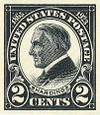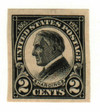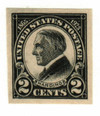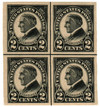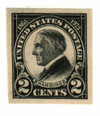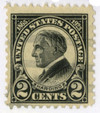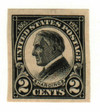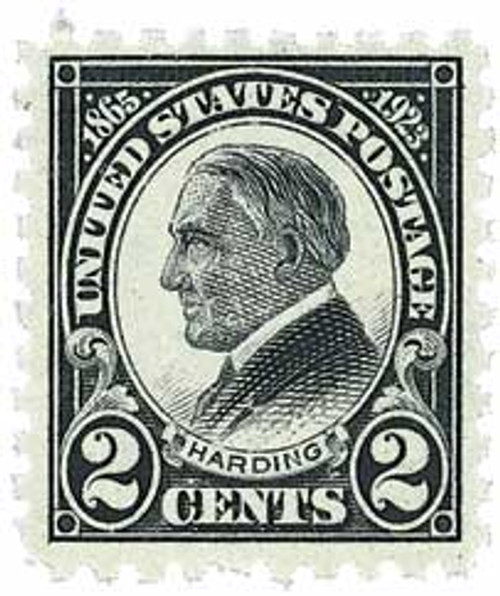
# 611 - 1923 2c Harding, black, imperforate
1923 2¢ Harding Memorial Issue
Imperforate
First City: Washington, DC
Quantity Issued: 770,000
Printed by: Bureau of Engraving and Printing
Printing Method: Flat plate
Perforation: None
Color: Black
Harding then moved to Marion, Ohio, and bought the struggling Marion Star newspaper in 1884. Though he wrote in support of the Republican Party, his fair reporting of both sides earned him the respect of Ohio politicians. Within ten years, Harding’s paper grew to be one of the most popular in the county. And when Harding reorganized his business, he allowed them to buy stock in Harding Publishing Co., the first profit-sharing agreement in Ohio.
Harding began his political career in 1899, when he won a seat in the Ohio State Senate. After serving two terms, Harding ran for governor of Ohio in 1903. He was defeated, but was given the position of lieutenant governor. In 1914, he was elected to the US Senate, a post he held until his presidential inauguration in 1921.
In running for the presidency in 1920, Harding promised to return America “to normalcy” and healing from World War I and the policies of President Wilson. Harding conducted a front-porch campaign from his home in Marion, Ohio, while his opponent traveled over 20,000 miles. Over 600,000 people came to visit him. In addition, entertainers such as Al Jolson and Mary Pickford entertained the crowds. Henry Ford and Thomas Edison also met with Harding and supported his campaign.
The results of November’s election were the first in US history to be covered on the radio. Harding and his running mate Calvin Coolidge received 60 percent of the national vote, the highest percentage ever recorded up to that time.
During his campaign, Harding promised to appoint the best men he could find for his Cabinet. Some of his choices fulfilled this promise. Unfortunately, he also felt a sense of duty to men who supported his run for office and gave them influential positions as well. These men, later called the “Ohio gang,” would damage Harding’s presidency. Many historians believe Harding was not aware of the corruption happening inside his administration. However, his choice of questionable men to serve in his Cabinet tarnished the reputation of his administration.
Harding worked to make the Federal government smaller and more efficient. The Budget and Accounting Act of 1921 said the President must submit a budget to the Congress each year. The General Accounting Office provided oversight for Federal expenses. As director, Charles Dawes reduced government spending by 25 percent the first year and cut it in half after two years.
The President felt lowering tax rates would help the country recover from the postwar depression it was experiencing. Under the guidance of Andrew Mellon, the top tax rate was reduced from 73 percent to 25 over the course of four years. Unemployment fell and tax revenue increased. Historians Schweikart and Allen wrote the economic policies “... produced the most vibrant eight year burst of manufacturing and innovation in the nation’s history.”
Ongoing labor disputes led to violence during Harding’s administration, and more than once he had to call in federal troops to bring peace. In a time when the rights of African Americans were severely limited, Harding supported civil rights and educational opportunities. He advocated for a Federal anti-lynching bill, but it was defeated in the Senate.
On November 21, 1921, Harding signed the Sheppard-Towner Maternity Act, which funded health centers around the country. It was the first large Federal social welfare program in America. The law encouraged doctors to offer health care to prevent illness as well as treating it. Child welfare workers were trained to make sure children were being taken care of.
Harding relied heavily on Secretary of State Charles Evans Hughes to conduct foreign affairs. Hughes led the Washington Armament Conference to reduce naval power in the hopes of maintaining peace. The U.S. hosted Japan, Great Britain, France, Italy, China, Belgium, Netherlands, and Portugal for the three-month conference. The agreements reached brought stability to the Pacific region. Trade agreements with China were also signed.
Harding improved the nation’s relationship with countries to the south. The Thomson-Urrutia Treaty awarded Colombia $25 million as payment for land used for the Panama Canal. The President also improved relations with Mexico, which had been strained during Wilson’s administration. Under Harding’s direction, the military began leaving occupied areas of Central America and the Caribbean.
In 1923, scandals in Harding’s administration were beginning to surface. He told a journalist, “I have no trouble with my enemies, but my friends, they’re the ones that keep me walking the floor at nights!” The President’s health was suffering, so he decided to take a tour to the West and Alaska to reconnect with the people and promote his agenda. Accompanied by his wife and trusted advisors, Harding’s train left Washington on June 20. After giving speeches throughout the Midwest, he and his party traveled to Alaska. Harding was the first President to visit there.
On the way back to the lower 48 states, Harding toured British Columbia, the first sitting President to visit Canada. As the trip continued, Harding became progressively weaker. The train traveled to San Francisco. On August 2, Harding died in a hotel suite of an apparent heart attack. The President’s body was transported by train across the country. Millions of Americans lined the track all along the route to pay their respects. His state funeral took place on August 8 in the Capitol building. Harding’s term was the shortest of any President in the 20th century.
First Modern First Day Cover
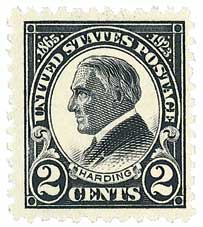
On September 1, 1923, George Linn produced the first cacheted First Day Covers, giving birth to the modern FDC industry.
President Warren G. Harding died suddenly on August 2, 1923. He was beloved across the country at the time and three million mourners gathered to watch his funeral train pass by. The New York Times called it “the most remarkable demonstration in American history of affection, respect, and reverence for the dead.
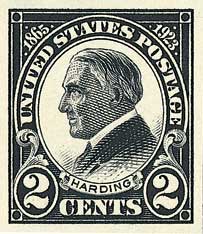
As was customary, the U.S. Post Office immediately began work on a memorial stamp to be issued on September 1, 1923. George Linn, who would later found Linn’s Stamp News, greatly admired Harding and wanted to do something special to mark the stamp’s issue. He chose to print a black five-line cachet with a black border on a variety of envelopes to affix the stamps to.
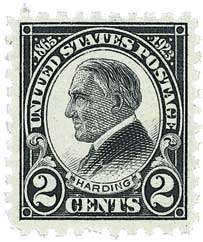
Before this time, virtually all First Day Covers were uncacheted – having no design or inscription relating to the subject of the stamp on the cover. He then drove from Columbus to Marion, Ohio to get his envelopes canceled. Linn’s covers were popular and are often considered the beginning of modern First Day Covers.
U.S. #610 was a special stamp that was to be issued for a limited time of about 60 to 90 days. Of the 200,000 copies sent to Marion, Ohio (Harding’s hometown), 180,000 were sold the first day of issue.
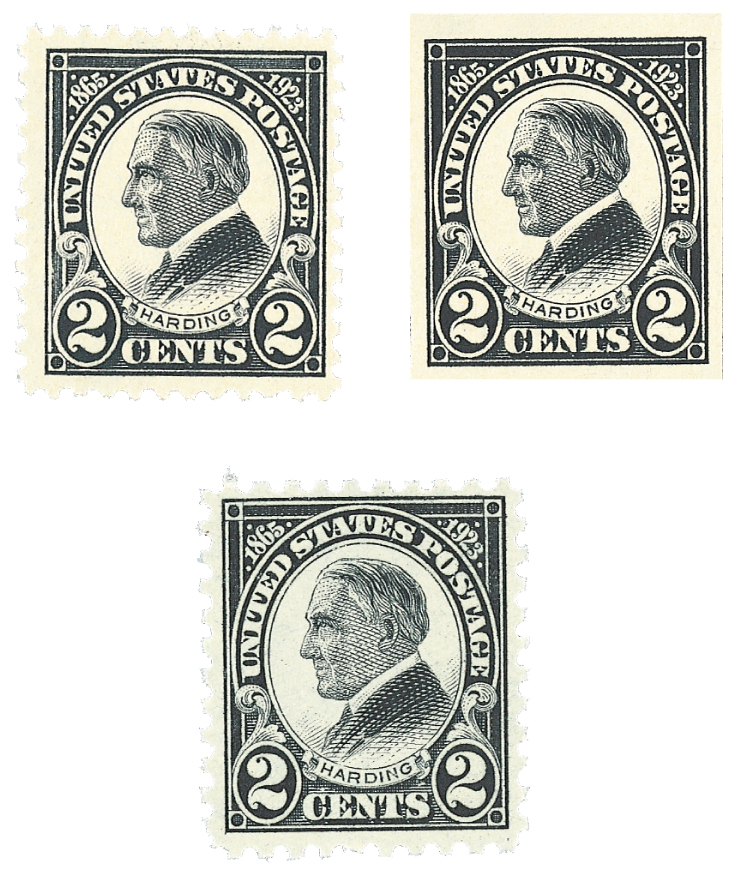
Demand for this stamp was far greater than for any previous special issue. It was impossible to meet the demand by printing from flat plates alone. The Bureau of Engraving and Printing was finally authorized to supplement that printing with a rotary press version. This was the first commemorative or memorial stamp issued using two printing methods. Eventually, over one billion stamps were issued, stretching the original 60-day limit to nearly 6 full months.
Another exciting aspect of the Harding Memorial issue is a perforation error that was found – Scott #613. It was perforated 11 on a rotary press, instead of 10.
Click here to view one of Linn’s covers.
1923 2¢ Harding Memorial Issue
Imperforate
First City: Washington, DC
Quantity Issued: 770,000
Printed by: Bureau of Engraving and Printing
Printing Method: Flat plate
Perforation: None
Color: Black
Harding then moved to Marion, Ohio, and bought the struggling Marion Star newspaper in 1884. Though he wrote in support of the Republican Party, his fair reporting of both sides earned him the respect of Ohio politicians. Within ten years, Harding’s paper grew to be one of the most popular in the county. And when Harding reorganized his business, he allowed them to buy stock in Harding Publishing Co., the first profit-sharing agreement in Ohio.
Harding began his political career in 1899, when he won a seat in the Ohio State Senate. After serving two terms, Harding ran for governor of Ohio in 1903. He was defeated, but was given the position of lieutenant governor. In 1914, he was elected to the US Senate, a post he held until his presidential inauguration in 1921.
In running for the presidency in 1920, Harding promised to return America “to normalcy” and healing from World War I and the policies of President Wilson. Harding conducted a front-porch campaign from his home in Marion, Ohio, while his opponent traveled over 20,000 miles. Over 600,000 people came to visit him. In addition, entertainers such as Al Jolson and Mary Pickford entertained the crowds. Henry Ford and Thomas Edison also met with Harding and supported his campaign.
The results of November’s election were the first in US history to be covered on the radio. Harding and his running mate Calvin Coolidge received 60 percent of the national vote, the highest percentage ever recorded up to that time.
During his campaign, Harding promised to appoint the best men he could find for his Cabinet. Some of his choices fulfilled this promise. Unfortunately, he also felt a sense of duty to men who supported his run for office and gave them influential positions as well. These men, later called the “Ohio gang,” would damage Harding’s presidency. Many historians believe Harding was not aware of the corruption happening inside his administration. However, his choice of questionable men to serve in his Cabinet tarnished the reputation of his administration.
Harding worked to make the Federal government smaller and more efficient. The Budget and Accounting Act of 1921 said the President must submit a budget to the Congress each year. The General Accounting Office provided oversight for Federal expenses. As director, Charles Dawes reduced government spending by 25 percent the first year and cut it in half after two years.
The President felt lowering tax rates would help the country recover from the postwar depression it was experiencing. Under the guidance of Andrew Mellon, the top tax rate was reduced from 73 percent to 25 over the course of four years. Unemployment fell and tax revenue increased. Historians Schweikart and Allen wrote the economic policies “... produced the most vibrant eight year burst of manufacturing and innovation in the nation’s history.”
Ongoing labor disputes led to violence during Harding’s administration, and more than once he had to call in federal troops to bring peace. In a time when the rights of African Americans were severely limited, Harding supported civil rights and educational opportunities. He advocated for a Federal anti-lynching bill, but it was defeated in the Senate.
On November 21, 1921, Harding signed the Sheppard-Towner Maternity Act, which funded health centers around the country. It was the first large Federal social welfare program in America. The law encouraged doctors to offer health care to prevent illness as well as treating it. Child welfare workers were trained to make sure children were being taken care of.
Harding relied heavily on Secretary of State Charles Evans Hughes to conduct foreign affairs. Hughes led the Washington Armament Conference to reduce naval power in the hopes of maintaining peace. The U.S. hosted Japan, Great Britain, France, Italy, China, Belgium, Netherlands, and Portugal for the three-month conference. The agreements reached brought stability to the Pacific region. Trade agreements with China were also signed.
Harding improved the nation’s relationship with countries to the south. The Thomson-Urrutia Treaty awarded Colombia $25 million as payment for land used for the Panama Canal. The President also improved relations with Mexico, which had been strained during Wilson’s administration. Under Harding’s direction, the military began leaving occupied areas of Central America and the Caribbean.
In 1923, scandals in Harding’s administration were beginning to surface. He told a journalist, “I have no trouble with my enemies, but my friends, they’re the ones that keep me walking the floor at nights!” The President’s health was suffering, so he decided to take a tour to the West and Alaska to reconnect with the people and promote his agenda. Accompanied by his wife and trusted advisors, Harding’s train left Washington on June 20. After giving speeches throughout the Midwest, he and his party traveled to Alaska. Harding was the first President to visit there.
On the way back to the lower 48 states, Harding toured British Columbia, the first sitting President to visit Canada. As the trip continued, Harding became progressively weaker. The train traveled to San Francisco. On August 2, Harding died in a hotel suite of an apparent heart attack. The President’s body was transported by train across the country. Millions of Americans lined the track all along the route to pay their respects. His state funeral took place on August 8 in the Capitol building. Harding’s term was the shortest of any President in the 20th century.
First Modern First Day Cover

On September 1, 1923, George Linn produced the first cacheted First Day Covers, giving birth to the modern FDC industry.
President Warren G. Harding died suddenly on August 2, 1923. He was beloved across the country at the time and three million mourners gathered to watch his funeral train pass by. The New York Times called it “the most remarkable demonstration in American history of affection, respect, and reverence for the dead.

As was customary, the U.S. Post Office immediately began work on a memorial stamp to be issued on September 1, 1923. George Linn, who would later found Linn’s Stamp News, greatly admired Harding and wanted to do something special to mark the stamp’s issue. He chose to print a black five-line cachet with a black border on a variety of envelopes to affix the stamps to.

Before this time, virtually all First Day Covers were uncacheted – having no design or inscription relating to the subject of the stamp on the cover. He then drove from Columbus to Marion, Ohio to get his envelopes canceled. Linn’s covers were popular and are often considered the beginning of modern First Day Covers.
U.S. #610 was a special stamp that was to be issued for a limited time of about 60 to 90 days. Of the 200,000 copies sent to Marion, Ohio (Harding’s hometown), 180,000 were sold the first day of issue.

Demand for this stamp was far greater than for any previous special issue. It was impossible to meet the demand by printing from flat plates alone. The Bureau of Engraving and Printing was finally authorized to supplement that printing with a rotary press version. This was the first commemorative or memorial stamp issued using two printing methods. Eventually, over one billion stamps were issued, stretching the original 60-day limit to nearly 6 full months.
Another exciting aspect of the Harding Memorial issue is a perforation error that was found – Scott #613. It was perforated 11 on a rotary press, instead of 10.
Click here to view one of Linn’s covers.




